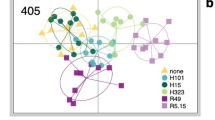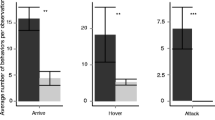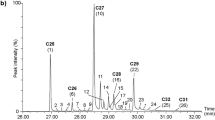Abstract
Lysiphlebus cardui, the dominant aphidiid parasitoid of the black bean aphid,Aphis fabae cirsiiacanthoidis (Afc), on creeping thistle, is able to forage in ant-attended aphid colonies without being attacked by ants. Several behavioral observations and experimental studies led to the hypothesis thatL. cardui mimics the cuticular hydrocarbon profile of its host aphid. Chemical analysis of the cuticular extracts revealed that bothL. cardui and Afc exclusively possess saturated hydrocarbons:n-alkanes, monomethyl (MMA), dimethyl (DMA), and trimethyl alkanes (TMA). Comparison of the hydrocarbon profiles of parasitoid and aphid showed great qualitative resemblance between parasitoid and host:L. cardui possesses almost all host-specific compounds in addition to species-specific hydrocarbons of mainly higher molecular weight (>C30). However, there is a lesser quantitative correspondence between parasitoid and host aphid. Furthermore, we analyzed the cuticular hydrocarbon profile of another parasitoid of Afc,Trioxys angelicae. This aphidiid species is vigorously attacked and finally killed by honeydewcollecting ants when encountered in aphid colonies. Its cuticular hydrocarbon profile is characterized by the presence of large amounts of (Z)-11-alkenes of chain lenghts C27, C29, C31, and C33, in addition to alkanes and presumably trienes. The role of the unsaturated hydrocarbons onT. angelicae as recognition cues for aphid-attending ants is discussed.
Similar content being viewed by others
References
Blomquist, G. J., andDillwith, J. W. 1985. Cuticular lipids, pp. 117–154,in G. A. Kerkut and L. J. Gilbert (eds.). Comprehensive Insect Physiology, Biochemistry and Pharmacology, Vol. 3. Pergamon Press, Oxford.
Blomquist, G. J., Tillman-Wall, J. A., Guo, L., Quilici, D. R., Gu, P., andScahl, C. 1993. Hydrocarbon and hydrocarbon derived sex pheromones in Insects: Biochemistry and endocrine regulation, pp. 317–351,in D. W. Stanley-Samuelson and D. R. Nelson (eds.). Insect Lipids: Chemistry, Biochemistry and Biology. University of Nebraska Press, Lincoln.
Bonavita-Cougourdan, A., Clément, J. L., andLange, C. 1987. Nestmate recognition: The role of cuticular hydrocarbons in the antCamponotus vagus Scop.J. Entomol. Sci. 22:1–10.
Bonavita-Cougourdan, A., Clément, J. L., andLange, C. 1993. Functional subcaste discrimination (foragers and brood-tenders) in the antCamponotus vagus Scop.: Polymorphism of cuticular hydrocarbon patterns.J. Chem. Ecol. 19:1461–1477.
Dettner, K., andLiepert, C. 1994. Chemical mimicry and camouflage.Annu. Rev. Entomol. 39:129–154.
Dunkelblum, E., Tan, S. H., andSilk, P. J. 1985. Double-bond location in monounsaturated fatty acids by dimethyl disulfide derivatization and mass spectrometry: Application to analysis of fatty acids in pheromone glands of four Lepidoptera.J. Chem. Ecol. 11:265–277.
Franks, N., Blum, M. S., Smith, R. K., andAllies, A. B. 1990. Behavior and chemical disguise of cuckoo antLeptothorax kutteri in relation to its hostLeptothorax acervorum.J. Chem. Ecol. 16:1431–1444.
Howard, R. W. 1993. Cuticular hydrocarbons and chemical communication, pp. 179–226,in D. W. Stanley-Samuelson and D. R. Nelson (eds.). Insect Lipids: Chemistry, Biochemistry and Biology. University of Nebraska Press, Lincoln.
Howard, R. W., Stanley-Samuelson, D. W., andAkre, R. D. 1990. Biosynthesis and chemical mimicry of cuticular hydrocarbons from the obligate predator,Microdon albicomatus Novak (Diptera: Syrphidae) and its ant prey,Myrmica incompleta Provancher (Hymenoptea: Formicidae).J. Kans. Entomol. Soc. 63:437–443.
Jackson, L. L., andBlomquist, G. J. 1976. Insect waxes, pp. 201–233,in P. E. Kolattukudy (ed.). Chemistry and Biochemistry of Natural Waxes. Elsevier Scientific Publishing, Amsterdam.
Jones, R. L., Lewis, W. J., Bowman, M. C., Beroza, M., andBierl, B. A. 1971. Host-seeking stimulant for parasite of corn earworm: Isolation, identification, and synthesis.Science 173:842–843.
Liepert, C., andDettner, K. 1993. Recognition of aphid parasitoids by honeydew-collecting ants: The role of cuticular lipids in a chemical mimicry systems.J. Chem. Ecol. 19:2143–2153.
Lockey, K. H. 1988. Lipids of the insect cuticle: Origin, composition and function.Comp. Biochem. Physiol. 89 B:595–645.
Mackauer, M., andVölkl, W. 1993. Regulation of aphid populations by aphidiid wasps: Does aphidiid foraging behaviour or hyperparasitism limit impact?Oecologia 94:339–350.
McCarthy, E. D., Han, J., andCalvin, M. 1968. Hydrogen atom transfer in mass spectrometric fragmentation patterns of saturated aliphatic hydrocarbons.Anal. Chem. 40:1475–1480.
Starý, P. 1966. Aphid parasites (Hymenoptera, Aphidiidae) and their relationship to aphid-attending ants, with respect to biological control.Insectes Soc. 13:185–202.
Starý, P., andVölkl, W. 1988. Aggregations of aphid parasitoid adults (Hymenoptera, Aphidiidae).J. Appl. Entomol. 105:270–279.
Stowe, M. K. 1988. Chemical mimicry, pp. 513–580,in K. C. Spencer (ed.). Chemical Mediation of Coevolution. Academic Press, New York.
Takada, H., andHashimoto, Y. 1985. Association of the aphid parasitoidsAclitus sappaphis andParalipsis eikoae (Hymenoptera, Aphidiidae) with the aphid-attending antsPheidole fervida andLasius niger (Hymenoptera, Formicidae).Kontyû 53:150–160.
Vander Meer, R. K., andWoicik, D. P. 1982. Chemical mimicry in the myrmecophilous beetleMyrmecaphodius excavaticollis.Science 218:806–808.
Völkl, W. 1990. Fortpflanzungsstrategien bei Blattlausparasitoiden (Hymenoptera: Aphidiidae): Konsequenzen ihrer Interaktionen mit Wirten und Ameisen. PhD thesis. University of Bayreuth, Bayreuth, Germany.
Völkl, W. 1992. Aphids or their parasitoids: Who actually benefits from ant-attendance?J. Anim. Ecol. 61:273–281.
Völkl, W., andMackauer, M. 1993. Interactions between ants and parasitoid wasps foraging forAphis fabae ssp.cirsiiacanthoidis on thistles.J. Insect Behav. 6:301–312.
Völkl, W., Hübner, G., andDettner, K. 1994. Interactions betweenAlloxysta brevis (Hymenoptera, Cynipoidea, Alloxystidae) and honeydew-collecting ants: How an aphid hyperparasitoid overcomes ant aggression by chemical denfense.J. Chem. Ecol. 20:2901–2915.
Author information
Authors and Affiliations
Rights and permissions
About this article
Cite this article
Liepert, C., Dettner, K. Role of cuticular hydrocarbons of aphid parasitoids in their relationship to aphid-attending ants. J Chem Ecol 22, 695–707 (1996). https://doi.org/10.1007/BF02033579
Received:
Accepted:
Issue Date:
DOI: https://doi.org/10.1007/BF02033579




